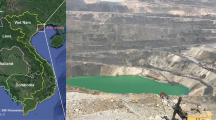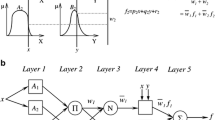Abstract
In addition to all benefits of blasting in mining and civil engineering applications, blasting has some undesirable impacts on surrounding areas. Blast-induced air-overpressure (AOp) is one of the most important environmental impacts of blasting operation which may cause severe damage to nearby residents and structures. Hence, it is a major concern to predict and subsequently control the AOp due to blasting. This paper presents an adaptive neuro-fuzzy inference system (ANFIS) model for prediction of blast-induced AOp in quarry blasting sites. For this purpose, 128 blasting operations were monitored in three quarry sites, Malaysia. Several models were constructed to obtain the optimum model in which each model involved five inputs and one output. Values of maximum charge per delay, powder factor, burden to spacing ratio, stemming length, and distance between monitoring station and blast face were set as input parameters to predict AOp. For comparison purposes, considering the same data, AOp values were predicted through the pre-developed artificial neural network (ANN) model and multiple regression (MR) technique. The results demonstrated the superiority of the ANFIS model to predict AOp compared to other methods. Moreover, results of sensitivity analysis indicated that the maximum charge per delay and powder factor and distance from the blast face are the most influential parameters on AOp.
















Similar content being viewed by others
References
Bahrami A, Monjezi M, Goshtasbi K, Ghazvinian A (2011) Prediction of rock fragmentation due to blasting using artificial neural network. Eng Comput 27(2):177–181
Baker WE, Cox PA, Kulesz JJ, Strehlow RA, Westine PS (1983) Explosion hazards and evaluation. Elsevier Science
Bhandari S (1997) Engineering Rock Blasting Operations. A.A. Balkema, Netherlands
Dowding CH (2000) Construction vibrations. In: Dowding, editor, pp 204–207
Dreyfus G (2005) Neural Networks: methodology and application, 2nd edn. Springer, Berlin Heidelberg
Du KL, Lai AKY, Cheng KKM, Swamy MNS (2002) Neural methods for antenna array signal processing: a review. Signal Process 82:547–561
Ebrahimi E, Monjezi M, Khalesi MR, Jahed Armaghani D (2015) Prediction and optimization of back-break and rock fragmentation using an artificial neural network and a bee colony algorithm. Bull Eng Geol Environ. doi:10.1007/s10064-015-0720-2
Engelbrecht AP (2007) Computational intelligence: an introduction. Wiley
Fausett, LV (1994) Fundamentals of Neural Networks: Architecture, Algorithms and Applications: Prentice-Hall, Englewood Cliffs
Ghoraba S, Monjezi M, Talebi N, Moghadam MR, Jahed Armaghani D (2015) Prediction of ground vibration caused by blasting operations through a neural network approach: a case study of Gol-E-Gohar Iron Mine, Iran. J Zhejiang Univ Sci A. doi:10.1631/jzus.A1400252
Gokceoglu C, Zorlu K (2004) A fuzzy model to predict the uniaxial compressive strength and the modulus of elasticity of a problematic rock. Eng Appl Artif Intell 17:61–72
Griffiths MJ, Oates JAH, Lord P (1978) The propagation of sound from quarry blasting. J Sound Vib 60:359–370
Grima MA, Bruines PA, Verhoef PNW (2000) Modeling tunnel boring machine performance by neuro-fuzzy methods. Tunn Undergr Space Technol 15(3):260–269
Hagan MT, Demuth HB, Beale MH (1996) Neural network design. Pws Pub, Boston
Hajihassani M, Jahed Armaghani D, Sohaei H, Tonnizam Mohamad E, Marto A (2014) Prediction of airblast-overpressure induced by blasting using a hybrid artificial neural network and particle swarm optimization. Appl Acoust 80:57–67
Hajihassani M, Jahed Armaghani D, Monjezi M, Mohamad ET, Marto A (2015) Blast-induced air and ground vibration prediction: a particle swarm optimization-based artificial neural network approach. Environ Earth Sci. doi:10.1007/s12665-015-4274-1
Haykin S (1999) Neural networks, 2nd edn. Prentice-Hall, Englewood Cliffs
Hopler RB (1998) Blasters' Handbook. International Society of Explosives Engineers
Hornik K, Stinchcombe M, White H (1989) Multilayer feedforward networks are universal Approximators. Neural Netw 2:359–366
Hustrulid WA (1999) Blasting principles for open pit mining: General design concepts. Balkema
Iphar M, Yavuz M, Ak H (2008) Prediction of ground vibrations resulting from the blasting operations in an open-pit mine by adaptive neuro-fuzzy inference system. Environ Geol 56:97–107
Jahed Armaghani D, Hajihassani M, Tonnizam Mohamad E, Marto A, Noorani SA (2013) Blasting-induced flyrock and ground vibration prediction through an expert artificial neural network based on particle swarm optimization. Arab J Geosci. doi:10.1007/s12517-013-1174-0
Jahed Armaghani D, Tonnizam Mohamad E, Momeni E, Narayanasamy MS, Mohd For MA (2014a) An adaptive neuro-fuzzy inference system for predicting unconfined compressive strength and Young’s modulus: a study on Main Range granite. Bull Eng Geol Environ. doi:10.1007/s10064-014-0687-4
Jahed Armaghani D, Hajihassani M, Yazdani BB, Marto A, Tonnizam Mohamad E (2014b) Indirect measure of shale shear strength parameters by means of rock index tests through an optimized artificial neural network. Measurement 55:487–498
Jahed Armaghani D, Hajihassani M, Monjezi M, Mohamad ET, Marto A, Moghaddam MR (2015) Application of two intelligent systems in predicting environmental impacts of quarry blasting. Arab J Geosci. doi:10.1007/s12517-015-1908-2
Jang RJS (1993) Anfis: adaptive-network-based fuzzy inference system. IEEE Trans Syst Man Cybern 23:665–685
Jang RJS, Sun CT, Mizutani E (1997) Neuro-fuzzy and soft computing. PTR Prentice Hall
Jin Y, Jiang J (1999) Techniques in neural-network based fuzzy system identification and their application to control of complex systems. Fuzzy theory systems, techniques and applications. Academic Press, New York, pp 112–128
Jong YH, Lee CI (2004) Influence of geological conditions on the powder factor for tunnel blasting. Int J Rock Mech Min Sci 41:533–538
Kaastra I, Boyd M (1996) Designing a neural network for forecasting financial and economic time series. Neuro Comput 10:215–236
Kalinli A, Acar MC, Gunduz Z (2011) New approaches to determine the ultimate bearing capacity of shallow foundations based on artificial neural networks and ant colony optimization. Eng Geol 117:29–38
Kanellopoulas I, Wilkinson GG (1997) Strategies and best practice for neural network image classification. Int J Remote Sensing 18:711–725
Khandelwal M, Kankar PK (2011) Prediction of blast-induced air overpressure using support vector machine. Arab J Geosci 4:427–433
Khandelwal M, Singh TN (2005) Prediction of blast induced air overpressure in opencast mine. Noise Vibration Worldwide 36:7–16
Khandelwal M, Singh TN (2006) Prediction of blast induced ground vibrations and frequency in opencast mine: a neural network approach. J Sound Vib 289:711–725
Kosko B (1994) Neural networks and fuzzy systems: a dynamical systems approach to machine intelligence. Prentice Hall, New Delhi, pp 12–17
Kuzu C, Fisne A, Ercelebi SG (2009) Operational and geological parameters in the assessing blast induced airblast-overpressure in quarries. Appl Acoust 70:404–411
Marto A, Hajihassani M, Jahed Armaghani D, Tonnizam Mohamad E, Makhtar AM (2014) A Novel Approach for Blast-Induced Flyrock Prediction Based on Imperialist Competitive Algorithm and Artificial Neural Network. Sci World J Article ID 643715
Masters T (1994) Practical neural network recipes in C++. Academic Press, Boston
McKenzie C (1990) Quarry blast monitoring: technical and environmental perspectives. Quarry Manag 17:23–34
Mohamed MT (2011) Performance of fuzzy logic and artificial neural network in prediction of ground and air vibrations. Int J Rock Mech Min Sci 48:845–851
Momeni E, Nazir R, Jahed Armaghani D, Maizir H (2014) Prediction of pile bearing capacity using a hybrid genetic algorithm-based ANN. Measurement 57:122–131
Monjezi M, Bahrami A, Varjani AY, Sayadi AR (2011) Prediction and controlling of flyrock in blasting operation using artificial neural network. Arab J Geosci 4:421–425
Monjezi M, Khoshalan HA, Varjani AY (2012a) Prediction of flyrock and back-break in open pit blasting operation: a neuro-genetic approach. Arab J Geosci 5:441–448
Monjezi M, Khoshalan HA, Razifard M (2012b) A neuro-genetic network for predicting uniaxial compressive strength of rocks. Geotech Geol Eng 30(4):1053–1062
Morhard RC (1987) Explosives and Rock Blasting. Atlas Powder Company
National Association of Australian State Road Authorities (1983) Explosives in Roadworks - A Users Guide. NAASRA, Sydney
Rezaei M, Monjezi M, Moghaddam SG, Farzaneh F (2012) Burden prediction in blasting operation using rock geomechanical properties. Arab J Geosci 5:1031–1037
Ripley BD (1993) Statistical aspects of neural networks. In: Barndoff- Neilsen OE, Jensen JL, Kendall WS (eds) Networks and chaos-statistical and probabilistic aspects. Chapman & Hall, London, pp 40–123
Roy PP (2005) Rock blasting: effects and operations. Taylor & Francis, US
Segarra P, Domingo JF, López LM, Sanchidrián JA, Ortega MF (2010) Prediction of near field overpressure from quarry blasting. Appl Acoust 71:1169–1176
Sezer EA, Nefeslioglu HA, Gokceoglu C (2014) An assessment onproducing synthetic samples by fuzzy C-means for limitednumber of data in prediction models. Appl Soft Comput 24:126–134
Shahin MA, Maier HR, Jaksa MB (2002) Predicting settlement of shallow foundations using neural networks. J Geotech Geoenviron Eng 128:785–793
Shirani Faradonbeh R, Monjezi M, Jahed Armaghani D (2015) Genetic programing and non-linear multiple regression techniques to predict backbreak in blasting operation. Eng Comput. doi:10.1007/s00366-015-0404-3
Simpson PK (1990) Artificial neural system-foundation, paradigm, application and implementations. Pergamon Press, New York
Siskind DE, Stachura VJ, Stagg MS, Kopp JW (1980) Structure response and damage produced by airblast from surface mining. United States Bureau of Mines, Twin Cities Research Center
Sonmez H, Gokceoglu C (2008) Discussion on the paper by H. Gullu and E. Ercelebi “A neural network approach for attenuation relationships: An application using strong ground motion data from Turkey”. Eng Geol 97:91–93
Sonmez H, Gokceoglu C, Nefeslioglu HA, Kayabasi A (2006) Estimation of rock modulus: for intact rocks with an artificial neural network and for rock masses with a new empirical equation. Int J Rock Mech Min Sci 43:224–235
Takagi T, Sugeno M (1985) Fuzzy identification of systems and its applications to modeling and control. IEEE Trans Syst Man Cybern 15:116–132
Tonnizam Mohamad E, Hajihassani M, Jahed Armaghani D, Marto A (2012) Simulation of blasting-induced air overpressure by means of artificial neural networks. Int Rev Model Simul 5:2501–2506
Tonnizam Mohamad E, Jahed Armaghani D, Hajihassani M, Faizi K, Marto A (2013) A simulation approach to predict blasting-induced flyrock and size of thrown rocks. Electr J Geotech Eng 18:365–374
Tonnizam Mohamad E, Jahed Armaghani D, Momeni E, Alavi Nezhad Khalil Abad SV (2014) Prediction of the unconfined compressive strength of soft rocks: a PSO-based ANN approach. Bull Eng Geol Environ. doi:10.1007/s10064-014-0638-0
Veelenturf Leo PJ (1995) Analysis and applications of artificial neural networks. Prentice hall, London
Wang C (1994) A theory of generalization in learning machines with neural application. PhD thesis, The University of Pennsylvania, USA
Wharton RK, Formby SA, Merrifield R (2000) Airblast TNT equivalence for a range of commercial blasting explosives. J Haz Mater 79:31–39
Wiss JF, Linehan PW (1978) Control of vibration and blast noise from surface coal mining, Wiss, Janney. Elstner and Associates, Inc., Northbrook
Yilmaz I, Yuksek G (2009) Prediction of the strength and elasticity modulus of gypsum using multiple regression ANN, and ANFIS models. Int J Rock Mech Min Sci 46:803–810
Acknowledgments
The authors would like to extend their appreciation to the Government of Malaysia and Universiti Teknologi Malaysia for the FRGS grant no. 4F406 and for providing the required facilities that made this research possible.
Author information
Authors and Affiliations
Corresponding author
Rights and permissions
About this article
Cite this article
Jahed Armaghani, D., Hajihassani, M., Sohaei, H. et al. Neuro-fuzzy technique to predict air-overpressure induced by blasting. Arab J Geosci 8, 10937–10950 (2015). https://doi.org/10.1007/s12517-015-1984-3
Received:
Accepted:
Published:
Issue Date:
DOI: https://doi.org/10.1007/s12517-015-1984-3




